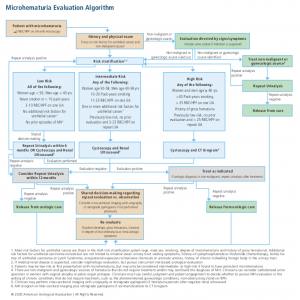Dr. Matthew Nielsen, Professor and Interim Chair of the Department, was a panelist and contributing author to the American Urological Association’s new 2020 Guideline for the evaluation of hematuria, released this week. The guideline will be presented by panel co-Chairs at the AUA Live Virtual Experience at 3:45pm on Saturday, June 27.
Hematuria is a common finding in clinical practice, with over 2 million American patients referred each year for evaluation, representing one of the most common diagnoses seen by urologists. The AUA panel aimed to develop and disseminate clear guideline recommendations for the evaluation of hematuria. This work sought to mitigate potentially avoidable risks and costs associated with the over-evaluation of patients at low risk for malignancy, while at the same time addressing the delays in diagnosis of important urologic conditions caused by widespread under-evaluation and variations in care. The new 2020 AUA Guideline provides an individualized, risk-stratified approach to hematuria evaluation based on the patient’s risk of harboring a urinary tract cancer.
Nielsen’s work in this area started with a collaboration with the American College of Physicians’ High Value Care Task Force, published in 2016. This effort highlighted unexplained variation in care and raised questions related to potentially avoidable costs and harms from existing recommendations at that time, which recommended uniform evaluation with CT for all adults with hematuria. Last summer, a team of investigators from UNC published a simulation modeling study in JAMA Internal Medicine examining tradeoffs of harm, benefit and cost associated with various strategies for hematuria evaluation, finding substantial potentially avoidable costs and harms from radiation exposure with a uniformly intensive approach.
“It was a privilege to be a part of this important effort from the AUA, and I’m very grateful for the leadership of the co-Chairs, other panelists, and AUA staff. We are hopeful that these new guidelines will provide clearer guidance and a patient-centered approach, reducing avoidable harms and costs for low-risk patients while enhancing early detection of disease for patients at greater risk.”
Matthew Nielsen, MD, MS, FACS
Interim Chair, Department of Urology
Professor of Urology


